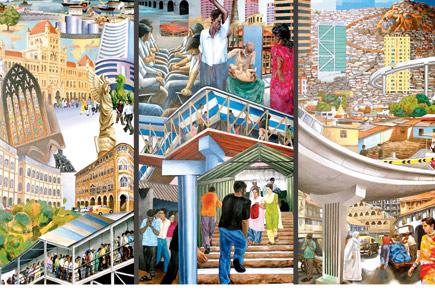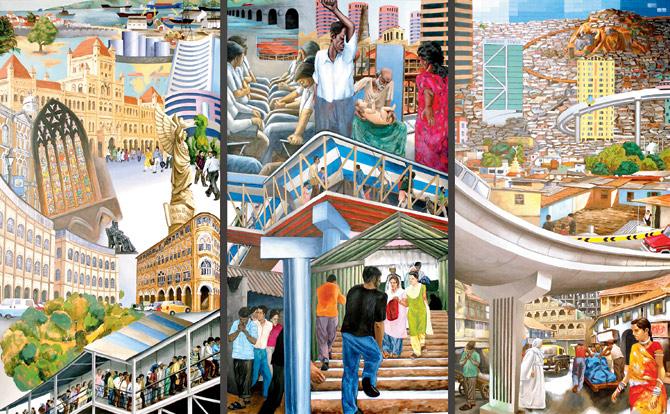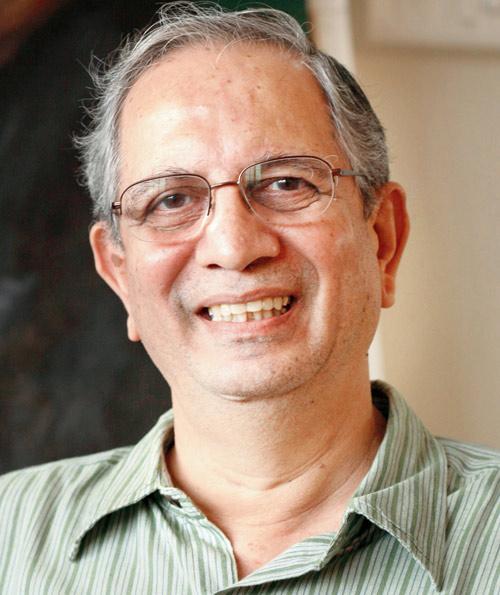From Mumbai to Paris, learn how cities reflect in the oeuvres of popular artists at a talk by veteran painter Sudhir Patwardhan

Three panels from Mumbai Proverbs, a seven-panelled, 7.5 x 28 ft artwork created in 2014
![]() Whether it’s a panorama of Ulhasnagar, a factory in Ambernath, a flyover construction or works depicting the agonies of the urban middle class and the poor, the cityscape has featured predominantly in Sudhir Patwardhan’s oeuvre over the last four decades. In fact, one of his popular works, Mumbai Proverbs, created in 2014, is a large-scale seven-panel artwork showcasing many hues of the metropolis.
Whether it’s a panorama of Ulhasnagar, a factory in Ambernath, a flyover construction or works depicting the agonies of the urban middle class and the poor, the cityscape has featured predominantly in Sudhir Patwardhan’s oeuvre over the last four decades. In fact, one of his popular works, Mumbai Proverbs, created in 2014, is a large-scale seven-panel artwork showcasing many hues of the metropolis.

Three panels from Mumbai Proverbs, a seven-panelled, 7.5 x 28 ft artwork created in 2014
ADVERTISEMENT
"The work is about experiencing Mumbai as it is today, its past as it is still around us, and its future implied in the direction the city is moving in. Hence, it’s a kind of historical narrative of the city," says the 66-year-old Patwardhan. Little surprise then that the Pune-born contemporary painter, who moved to Mumbai in 1973 and worked as radiologist in Thane till 2005, will conduct an illustrated talk titled, The City As Artists See It, tomorrow in Borivali. In the hour-long talk, supported by Urban Design Research Institute (UDRI) and Bombay City Policy Research Foundation, Patwardhan will discuss ways in which various artists have responded to living in a city, along with observations about his own works. 
Sudhir Patwardhan Artist
Excerpts:
Q. Which artists’ works do you plan to highlight in the talk?
A. I will be speaking about how Monet has seen Paris, or Bikash Bhattacharya has seen Calcutta, Gieve Patel, and some younger artists have seen Bombay, or how Jyothi Basu has seen a futuristic city. For instance, Patel’s work shows us unsuspected moments of beauty in the life of Mumbai, in spite of all the grime and degradation. Monet’s impressions of the railway station and the docks, while celebrating the new freedom of painting light, show us the modern industrial side of Paris.
Q. You’ve lived here since 1973. How has the city impacted your art?
A. The city, along with its people, has been the main subject of my work for over 40 years. My relationship with the city has undergone many changes; sometimes immersing myself in its street life or sometimes seeing the city from a distance. For example, the painting, Ulhasnagar, is a panorama, while a work like Tree is a street-level view of the city.
Q. Do you experience conflict in showing Mumbai the way it is or as a Utopian city?
A. There is no one view that can capture Mumbai. So, different aspects come in different works. The experience of the city as it is at that particular time is my main focus. Criticism of how it should not be, or projection of a Utopian view may come is as a corollary, but is not my main concern.
Q. Why did you feel the need to depict the agonies of the urban middle class and poor?
A. What you respond to, you paint. You are responding to the life of people around, and how the material structures of the city become a context for these lives.
On: April 1, 6.30 pm
At: School of Environment & Architecture, Eksar Road, Borivali (W).
Call: 65002156
Free Entry
 Subscribe today by clicking the link and stay updated with the latest news!" Click here!
Subscribe today by clicking the link and stay updated with the latest news!" Click here!







